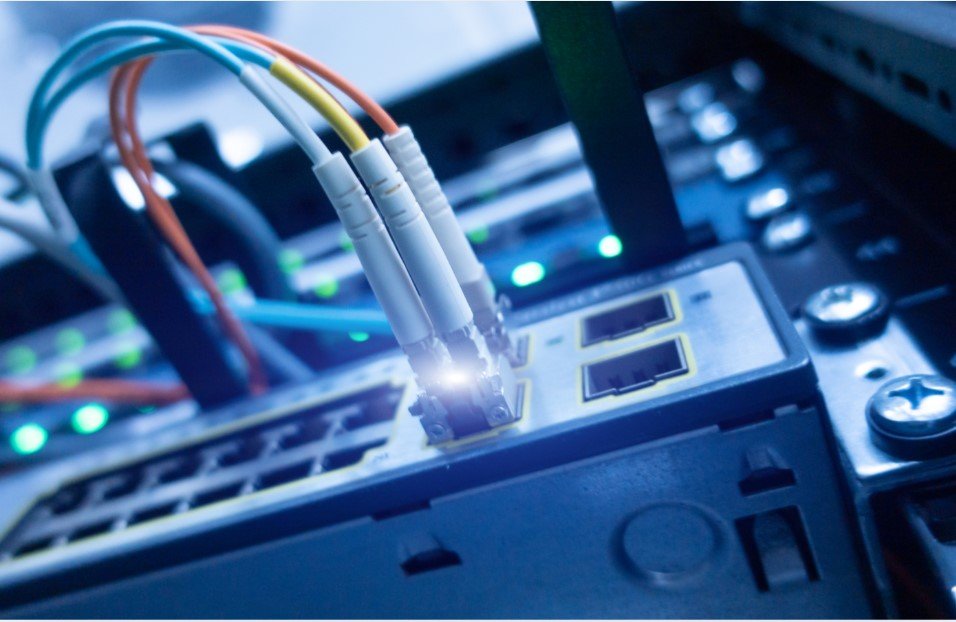Tech
Fibre Channel Switch: The Backbone of High-Speed Storage Networking
Published
22 hours agoon
By
Bella P
Every single day, more than 400 million terabytes of data are generated across the globe. That’s equivalent to millions of 4K videos, trillions of messages, billions of game interactions, and countless transactions. From cloud platforms to local servers, this massive amount of information must be stored, secured, and transferred without delay.
That’s where the Fibre Channel Switch comes in.
As the silent hero of enterprise data centers, a Fibre Channel switch ensures that huge volumes of critical data flow smoothly between servers and storage devices. It offers high-speed, low-latency communication and iron-clad reliability — essential for industries where even seconds of downtime can cost thousands of dollars.
But here’s the big question for 2025 and beyond:
Can Fibre Channel switches keep up with the growing demands of big data, AI, and ultra-fast workloads?
This in-depth guide explores what Fibre Channel switches are, how they work, where they fit in the modern tech landscape, and why they may continue to play a vital role in the future of high-performance networking.
What Is a Fibre Channel Switch?
A Fibre Channel Switch is a networking device specifically designed to manage high-speed data communication within a Storage Area Network (SAN). Unlike Ethernet switches that handle general data traffic, Fibre Channel switches are purpose-built for moving storage traffic between servers and storage systems with minimal latency and maximum reliability.
Think of it like this:
- A regular Ethernet switch is like a public highway for cars — it handles all types of traffic, from small cars to heavy trucks.
- A Fibre Channel switch, on the other hand, is like a dedicated high-speed railway for freight — streamlined, secure, and optimized for moving massive loads of valuable cargo (data).
Common Use Cases for Fibre Channel Switches:
- Hospitals storing and accessing patient health records in real time
- Financial institutions managing transactions with microsecond precision
- Educational institutions backing up critical academic and research data
- Manufacturing plants running mission-critical operations around the clock
- Cloud service providers offering high-availability enterprise storage
Why Big Data Needs Fibre Channel
What Is Big Data?
Big data refers to extremely large volumes of information that are complex, fast-growing, and difficult to manage with traditional tools. This includes structured and unstructured data from sources like:
- Customer transactions
- Social media platforms
- IoT sensors
- Medical imaging systems
- Video content creation
- Artificial intelligence models
Big data is characterized by the “3 Vs”: Volume, Velocity, and Variety. And these characteristics demand networks that are:
- Scalable (can grow with demand)
- Fast (can process data quickly)
- Reliable (can work 24/7 without failure)
This is why Fibre Channel switches continue to be a top choice for enterprises that rely on data-intensive operations.
How Fast Is Big Data Growing?
The numbers are mind-blowing.
- In 2023, global data generation reached 120 zettabytes.
- By 2028, that figure is expected to cross 394 zettabytes, according to IDC.
- 1 zettabyte = 1 billion terabytes.
With this exponential growth, the underlying networking infrastructure must evolve. Fibre Channel switches — with their high throughput and low-latency architecture — are built to keep pace.
Can Fibre Channel Switches Keep Up with Future Demands?
The short answer is: Yes — if they continue to evolve.
While Fibre Channel technology has historically been associated with legacy infrastructure, recent advancements have made it a strong contender in the world of modern, high-speed data centers.
Areas Where Fibre Channel Is Keeping Pace:
Speed Upgrades
- Modern Fibre Channel switches now support 32 Gbps and 64 Gbps speeds.
- Next-gen switches are already testing 128 Gbps (FC-NVMe) support.
Smarter Architecture
- Built-in traffic management ensures smooth data flows even during high load.
- Support for NVMe over Fibre Channel (FC-NVMe) enables faster SSD access.
Improved Storage Handling
- Ideal for handling large block-level data transfers, backups, and replication.
Efficient Power Consumption
- New models are designed for energy efficiency with reduced heat output.
The Role of Scalability in Modern Data Centers
Scalability is key to any enterprise IT environment. As workloads grow and applications become more data-hungry, the ability to scale the network becomes mission-critical.
Fibre Channel Switch Scalability Features:
- Port Expansion: Many switches support hundreds of ports — easily add more servers or storage.
- Fabric Expansion: Interconnect multiple switches to form a fabric — a larger networked system that acts as one.
- Non-Disruptive Growth: Add components without taking down the system.
Example:
A Fortune 500 retailer scales from 5 to 50 branch data centers. Using Fibre Channel switches, IT can interconnect SAN fabrics across locations without impacting performance.
Fibre Channel vs. Ethernet: Which Is Better for Big Data?
While Ethernet has made great strides with iSCSI and RDMA technologies, Fibre Channel still holds a strong advantage in environments where data consistency, uptime, and speed are non-negotiable.
| Feature | Fibre Channel Switches | Ethernet Switches |
|---|---|---|
| Purpose | Storage traffic only | General-purpose networking |
| Latency | Ultra-low | Higher (variable) |
| Packet Loss | Minimal | Higher risk |
| Performance | Predictable | Variable |
| Scalability | Built-in SAN scaling | Requires advanced configs |
| Security | Hardware-level zoning & access | Software-based |
Security and Data Protection in Fibre Channel Networks
With the explosion of data comes an equally large challenge: protecting that data.
Fibre Channel switches include powerful built-in tools to protect data at every point in the network.
Key Fibre Channel Security Features:
Zoning
- Controls which devices can communicate within the SAN.
- Reduces attack surface and limits exposure to unauthorized devices.
Encryption
- Protects data in motion using advanced cryptographic protocols.
- Essential for compliance in finance, healthcare, and government sectors.
Access Control
- Admins define access levels, ensuring that only approved users can view or modify data.
Reliability That Powers Growth
Fibre Channel switches are engineered for mission-critical environments where downtime is not an option.
Features That Support High Availability:
- Path Redundancy: Multiple data paths ensure failover in case of cable or hardware failure.
- Hot-Swappable Components: Replace hardware without stopping the system.
- Error Detection and Correction: Built-in intelligence to catch and fix problems before they escalate.
Real-World Example:
A healthcare provider uses Fibre Channel for 24/7 access to medical imaging systems. Even during maintenance or hardware failure, patient records remain available — a literal life-saver.
Industry Applications of Fibre Channel Switches
Healthcare
- Store large medical imaging files (MRI, CT scans)
- Ensure compliance with healthcare data regulations
Finance
- Enable secure, high-speed data transfers
- Support low-latency trading systems
Enterprise IT
- Backbone for enterprise backup and disaster recovery
- Integrate with hybrid and multi-cloud environments
Gaming & Streaming
- Power high-volume, low-latency content delivery systems
- Handle large user databases in real time
The Future of Fibre Channel: Where Are We Headed?
As we enter the AI era, the demands on data networks are intensifying. But instead of being replaced, Fibre Channel is evolving.
What’s Next:
- 128 Gbps Switches: Already in prototype, expected to launch commercially by 2026.
- NVMe Over Fabrics: Native support for NVMe is improving flash performance across SANs.
- AI Integration: Smart switches with built-in monitoring and auto-optimization tools.
- Hybrid SANs: Combining Fibre Channel with Ethernet for unified SAN/NAS environments.
Final Thoughts: Fibre Channel Switches Are Still the Future
A Fibre Channel Switch is more than a connector — it’s a performance engine. It powers the invisible highways of the modern data center, carrying critical information with unmatched speed, security, and reliability.
Yes, the world is creating more data than ever before. But Fibre Channel isn’t just keeping up — it’s leading the way, especially in enterprise environments that demand consistency and uptime.
So whether you’re running a data-intensive AI model, safeguarding patient health records, or managing a global transaction system, one thing is clear:
FAQs About Fibre Channel Switches
What is the primary purpose of a Fibre Channel switch?
To enable high-speed, low-latency data transfer between servers and storage in a Storage Area Network (SAN).
How fast are Fibre Channel switches today?
Modern switches support up to 64 Gbps, with 128 Gbps models emerging soon.
Are Fibre Channel switches better than Ethernet?
For storage-specific tasks, yes. Fibre Channel offers more consistent performance, lower latency, and better security.
Can Fibre Channel switches be used in cloud or hybrid environments?
Absolutely. Many cloud-integrated data centers use Fibre Channel as the backbone of their hybrid infrastructure.
Is Fibre Channel outdated?
Not at all. While it’s a mature technology, it’s still evolving with support for NVMe, AI-driven management, and future-proof speeds.
For More Updates And Stories Visit To: Dooper Magazine

Cevurı: The Future of Simplified Digital Transformation

Who Is Cade Foehner? All About Cade Foehner Singer & His Journey

Fibre Channel Switch: The Backbone of High-Speed Storage Networking

Prostavive Colibrim: A Natural Solution for Prostate Health

NSSession: The Key to Secure and Personalized Web Development

Video&a: Redefining Interactive Digital Experiences

Who Is Joris Bijdendijk? All About the Chef

Who is Bayard Martensen? Inside the Life of Charlie Carver’s Brother

Who Is Kevin Rankin? All About the American Actor

Who is Hue Jackson? The Story of the American Football Coach

Who Is John Besh? All About the American Chef

Who is Aasif Mandvi? All About the American Actor and Comedian

Who Is Sophie Marceau? All About the Iconic French Actress

Who Is Murray Cook? All About the Australian Musician

Who is Marina Alyabusheva? Life and Journey of Marina Alyabusheva, Teacher and Olga Kurylenko’s Mother

Who is Todd Blackledge: All About the American Former Football Quarterback

Who is Enrique Castillo All About the American Actor and Writer

Who is Eddie Barbanell? All About the American Actor Making an Impact

Who is Dream Cazzaniga? The Rising Dancer and Donyale Luna’s Daughter

Who is Hue Jackson? The Story of the American Football Coach

Cevurı: The Future of Simplified Digital Transformation

Who Is Cade Foehner? All About Cade Foehner Singer & His Journey

Fibre Channel Switch: The Backbone of High-Speed Storage Networking

Prostavive Colibrim: A Natural Solution for Prostate Health

NSSession: The Key to Secure and Personalized Web Development

Video&a: Redefining Interactive Digital Experiences

Who Is Joris Bijdendijk? All About the Chef

Who is Bayard Martensen? Inside the Life of Charlie Carver’s Brother

Who Is Kevin Rankin? All About the American Actor

Who is Hue Jackson? The Story of the American Football Coach
Trending
-

 Celebrity7 months ago
Celebrity7 months agoWho Is Mindy Jennings? Inside the Life of Ken Jennings’ Wife
-

 Celebrity6 months ago
Celebrity6 months agoWho Is Angela Simmons? All About Her Business, Fame, and Personal Life
-

 Celebrity8 months ago
Celebrity8 months agoWho Is Alec Bohm & Jacque Darby? Inside Their Love Story & Marriage
-

 Celebrity8 months ago
Celebrity8 months agoWho is Debra Antney? The Powerhouse Talent Manager in Hip-Hop
